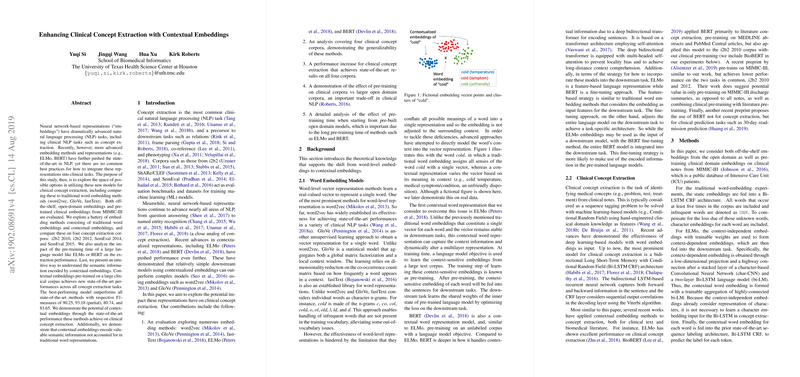Enhancing Clinical Concept Extraction with Contextual Embeddings
This paper explores the domain of clinical NLP, specifically focusing on the task of clinical concept extraction. Concept extraction in clinical narratives is a foundational task integral to various downstream NLP applications, such as relation extraction or phenotyping. While traditional word embeddings techniques like Word2Vec, GloVe, and FastText have been widely used in NLP, recent advancements in contextual embeddings such as ELMo and BERT promise to enhance the performance of clinical NLP tasks through a more informed understanding of word context.
The authors conducted a comprehensive paper to evaluate the effectiveness of various embedding strategies on clinical concept extraction tasks, leveraging both traditional word embeddings and more advanced contextual embeddings. They implemented experiments on four established clinical NLP datasets: i2b2 2010, i2b2 2012, SemEval 2014 (Task 7), and SemEval 2015 (Task 14). By employing open-domain embeddings and embeddings trained specifically on clinical data (from MIMIC-III), they benchmarked and compared the performance metrics using models like Bi-LSTM with CRF layers, further enhanced by embeddings obtained from open-domain general embeddings and those pre-trained on a clinical corpus.
The results of the paper indicated a marked improvement when contextual embeddings, namely those based on ELMo and BERT architectures, are pre-trained on domain-specific data. For instance, models using BERT\textsubscript{LARGE} pre-trained on MIMIC-III reached F1 scores of 90.25, 93.18 (partial), 80.74, and 81.65 across the respective datasets. This not only surpasses previous benchmarks but highlights that specificity in data pre-training coupled with advanced context sensitivity significantly elevates the performance of clinical concept extraction.
The implications from these findings suggest a promising future trajectory for clinical NLP tasks. Contextual embeddings trained on extensive clinical corpora, like MIMIC-III, demonstrate superior generalization capabilities and represent a substantial contribution to the improvement of clinical text processing tasks. The paper also emphasizes the need for optimal pre-training strategies that balance between open corpus learning and domain-specific fine-tuning to enhance task-specific NLP applications.
One noteworthy discussion point from the paper is the semantic clustering ability of contextual embeddings. These embeddings capture nuanced differences in word meanings based on context, which traditional embeddings fail to address. This quality is particularly important in medical terms where a single term might possess multiple meanings depending on its usage in a sentence.
For future directions, the authors suggest exploring domain-specific tokenization strategies, particularly pertinent due to the observations made with BERT's sub-word tokenization process. While this research paves the way toward enriching clinical NLP applications through advanced embeddings, further investigations into domain-specific pre-training practices, comprehensive evaluation methodologies, and new fine-tuning strategies promise continued improvements and diversification in approach.
In conclusion, the paper underscores the value and potential of contextual embeddings in clinical NLP, not only advancing concept extraction tasks but also promoting a broader exploration of semantic representation within domain-specific contexts. With ongoing advancements in AI and NLP, this research contributes to the foundational understanding necessary for developing more robust clinical LLMs.
